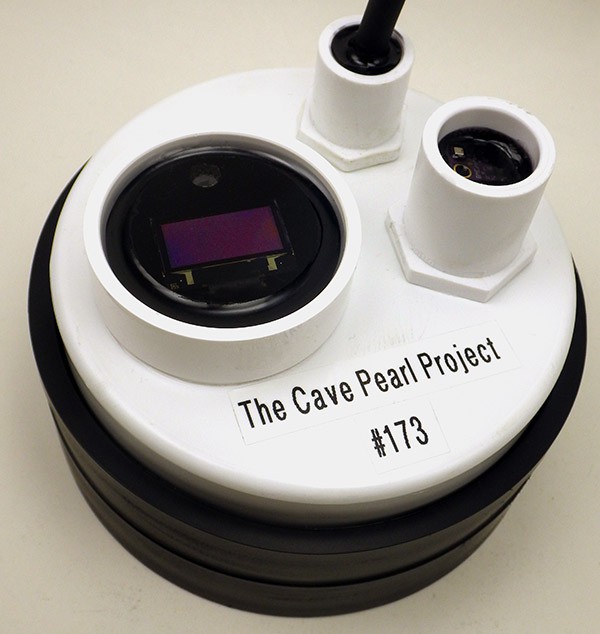-
Cave Pearls presented at 2018 GSA Conference
11/20/2018 at 21:57 • 0 commentsT25. GEOSCIENCE INFORMATION NEEDS IN EDUCATION AND RESEARCH
https://gsa.confex.com/gsa/2018AM/webprogram/Session45252.html
Session 178-3 #123 Building an Online Platform for Broader Impact & Outreach
In keeping with our opensource / DIY ethos, this project evolved entirely outside of institutional support & our traffic pattern is very different than that see by typical broader impact projects (ie those that actually have funding) . Perhaps most interesting is traffic from other countries, where our "hands on" tutorials see virtually no traffic from countries which access the web via mobile devices. Given that the Arduino can only be programmed via PC, this is likely inherent to the nature of the material rather than a bandwith/format issue.
-
Adding the SSD1306 OLED Screen to an Arduino Logger (without a library)
10/17/2018 at 19:32 • 0 commentsThis is the third in our series about using shift-out and unused analog lines to drive SPI displays. The primary reason to use this method is to save power in data logging applications that need to run for years at a time. When you drive the pin-power line down the screen is completely disabled and draws no current.
![]()
-
Starting Points & Ideas for your STEM Curriculum
10/10/2018 at 20:03 • 0 commentsAdding to our ongoing development of resources for Arduino instructors:
Starting Points & Ideas for your STEM Curriculum (k-12)
https://thecavepearlproject.org/2018/10/07/starting-points-ideas-for-an-arduino-stem-curriculum/accompanies the previously released:
Build your own Arduino Starter Kits for the Classroom
https://thecavepearlproject.org/2016/08/08/build-your-own-arduino-classroom/
-
Using the Arduino’s Internal EEprom to Store Calibration Data & LCD Screen Font
08/27/2018 at 14:28 • 0 commentsThis is a follow-up to our post about using Nokia 5110 screens on three unused analog lines with shift-out. That saved me from messing with the hardware SPI bus which we reserve for the SD cards. A secondary benefit is that the code is really lean, on the order of about 250 bytes for the default font after the compile if you already have EEprom.h in the build anyway. The font, however takes up about 500 bytes, and I wanted the smallest possible footprint so that we could add live data output to loggers that are already compile near the memory limits. As it turns out, stuffing those fonts into the internal EEprom was pretty easy to do:
Using the Arduino’s Internal EEprom to Store Calibration Data & LCD Screen Fonts -
Cave Pearl Logger: Underwater Deployment Video
07/18/2018 at 15:43 • 0 commentsWhile the 3-component core is generic, the surface deployments tend to use the 4" housing (which is easy to build) while the underwater deployments (about half of the current fleet) use the 2" body style. Usually those deployments are too deep to record with our little point & shoot camera, but we recently did an install in a coastal outflow that was shallow enough to capture a clip of the method we use to hold the sensors in place. In this video we are placing the anchor in the fresh water, with extension rods to move the actual sensor into the zone where saline water (the silty brown layer) in intruding into the system. All the elements of the system are made from zip ties & cheap plumbing parts.
-
VIDEO build tutorial released for the Cave Pearl Logger
06/19/2018 at 21:03 • 0 commentsA visiting researcher dropped by our humble basement workshop with questions about the physical skills their students would need to master if they added one of these DIY data loggers to their environmental curriculum. I figured the easiest way to cover that was to simply build one, while they recorded the process.
The result of that 3 hour session is now available on YouTube:
-
Adding a display to our Loggers with the fewest system resources
05/21/2018 at 16:46 • 0 commentsI had a project that needed some live data display, and looking for the cheapest low-power solution for our loggers lead me to the Nokia 5110 LCD. Once you get the backlight current under control, you can power the entire display from a digital pin, and if you use shiftout for soft SPI you can then get rid of the Reset and CS control lines. This brings the display down to any four wires you can spare on your build (incl. the power pin) and a ground line. This is much more manageable than what you see with the standard hookup guides if your mcu is I/O limited like our pro-mini based loggers:
-
The Cave Pearl Project is published!
02/10/2018 at 17:30 • 0 commentsThough it's not cherry red with a Bowie soundtrack, I am thrilled to announce that, after a very long trajectory, our first experimental vehicle is now in scientific orbit:
http://www.mdpi.com/1424-8220/18/2/530 ( PDF is free to download )
With the success of this first launch, the project is accelerating the timeline to meet some ambitious targets for the CPDL in 2018. The goal is to achieve several launches like this per year, carrying heavier data payloads, while simultaneously pushing the instruments even farther into "deep space".
-
Measuring Temperature with Two Clocks
02/10/2018 at 00:01 • 0 commentsThe resonators on cheap Pro Mini clones have so much thermal variation, that you can base a temperature sensing method on that alone:
https://thecavepearlproject.org/2018/02/03/measuring-temperature-with-two-clocks/
There is some rising/falling hysteresis that I'm still chewing on, and when I get brave enough to mess around with fuses, I'll re-try the method with the internal oscillator to see how that works.
-
The 2017 Cave Pearl Project ‘Year in Review’
01/03/2018 at 17:00 • 0 commentsI try to keep the Project blog tightly focused on the logger builds. But this year, I felt that I had to say something a bit more pointed about the events swirling around us all:
The Cave Pearl Project
Creating a generic data logging platform that is easy to build & modify for many different environmental monitoring projects.
 Ed Mallon
Ed Mallon